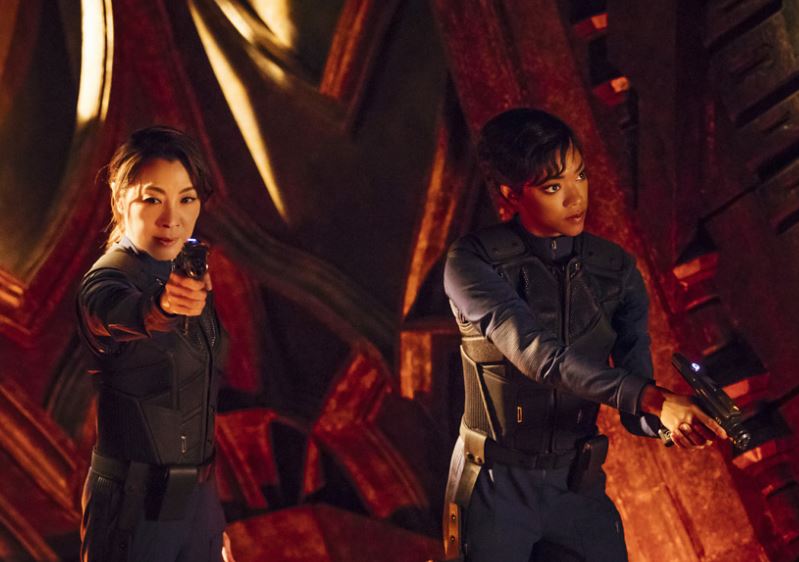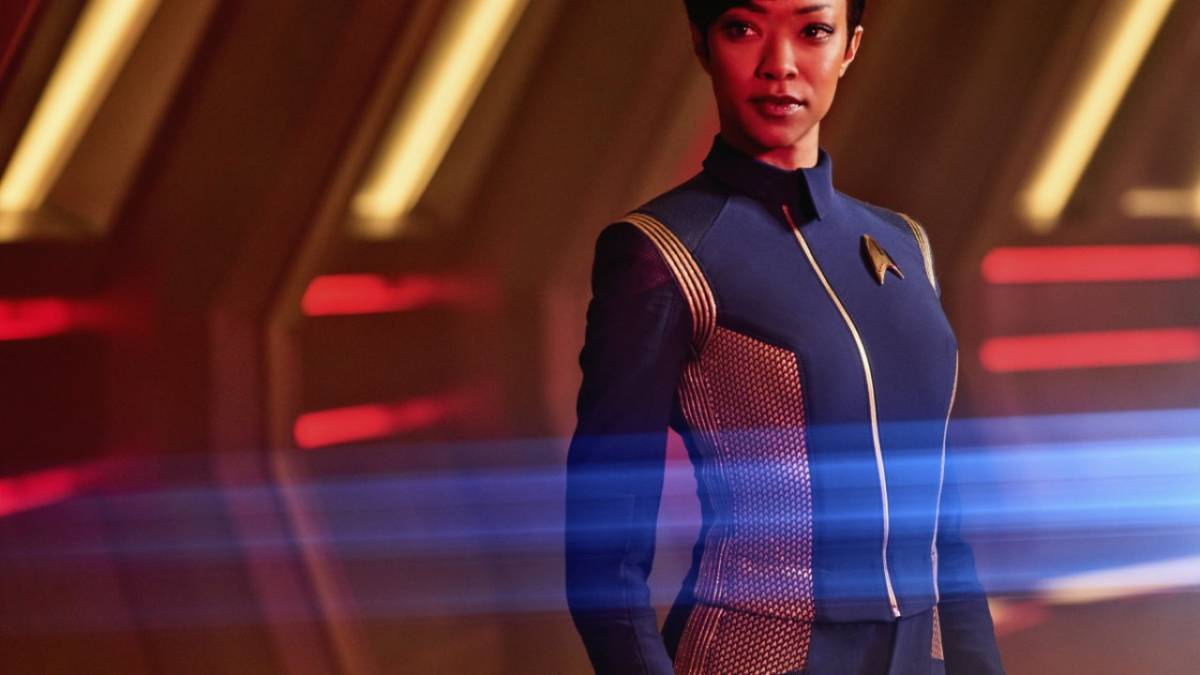It seems only fair to review the first two episodes of Star Trek: Discovery as a coherent whole – Netflix released them simultaneously, and their narratives flow together in such a way that they come off as less two separate episodes and more a single one-off tv movie. ‘The Vulcan Hello’ is a lot of set-up – it’s the first episode, after all, it has to lead us in gently – with ‘Battle at the Binary Stars’ taking, you may not be surprised to hear, a more action-y bent.
Speaking of feature-length presentations though, it’s worth mentioning that this is a move back to the small screen for a franchise that has, ever since Enterprise hit an iceberg under Scott Bakula’s command, existed mainly as film for a while. Discovery very specifically doesn’t take place in the same continuity as the reboots, but nonetheless you can see their influence. A big part of that is just aesthetic, and while you will by definition get fancier sets and space battles with bigger budgets and evolving effects, I also counted several Abrams-style lens flares in this opening salvo.
We follow young Michael Burnham, who in a departure from the Trek formula, is very definitely the main character while being the first officer rather than the captain – and, in a departure from a lot of the media landscape, is both black and a woman. The Original Series broke new ground by having Uhura right there on the bridge, but sad to say, she didn’t really get to do much – according to sources I just made up, when Nichelle Nichols sneezes it sounds like ‘hailing frequencies open, captain’ – so for Michael to be introduced out and about adventuring with Captain Georgiou (Michelle Yeoh) is more than welcome.

After saving a planet of horrible drought (what Prime Directive?), they’re off to investigate a Starfleet beacon that’s been messed with. Token alien Seru, from a race of ‘I got a bad feeling about this’ aliens, senses danger! They detect something nearby, hiding behind some asteroids in a rough patch of space. The USS Shenzhou is a little cumbersome to manoeuvre through there, so they send Michael out to take a look.
Now, there’s a lot of discourse about the representation of women and minorities onscreen, and the idea that they will be better able to see themselves in a black female protagonist than in the more usual string of white men. Whoopi Goldberg’s reaction to seeing Uhura onscreen, at nine years old, was famously ‘everybody, come quick…there’s a black lady on television and she ain’t no maid!’ Perhaps I’m unqualified to speak about how this works, but I’ll tell you one thing – everyone, be they black, white, Klingon, or even female, can take some vicarious joy in the idea of taking a one-person spacewalk in an awesome rocket spacesuit. And if you can’t, stick to Newsnight.
Speaking of Klingons though, when she goes in to investigate she gets jumped by one. This is after, as we learn, very little having been heard about them for years. And now, sad to say, the first tentative contact between Klingons and humanity is Michael killing the first one she sees. While they’re the overall aggressor, having been the ones to damage the beacon, it still leaves a sour taste.

The Klingons look fantastic. Possibly too good, in fact – the sheer weight of prosthetic on their faces means that a few of them end up speaking like they have a cold. This is most obvious with their mysterious and charismatic leader, T’kuvma, who despite the battlefield in his sinuses opens the episode with a villain speech about Klingon unity in the face of hu-mon aggression, and the recurrent lie of Starfleet, that ‘we come in peace’. Which would seem more fitting from aliens with a legitimate grievance, as opposed to the Klingons here, who basically come off as uruk-hai with workplace drama of their own.
Where Georgiou has Michael, T’kuvma, it seems, has Voq – an albino with no big name of his own, who’s in this mainly for the honour and glory. He volunteers as torchbearer to replace the guy Michael killed, and T’kuvma cheerfully grants this, because even if you’re obviously the baddy you can recognise how important plucky underdogs are to narrative structure.
Michael, due to Klingons-killed-her-parents-related trauma, is all for a first strike. Georgiou is more inclined to restraint – and controversially, so is the admiral they’ve called up for guidance. Starfleet admirals are usually basically just villains who the gang aren’t allowed to blow up, so this is wildly unexpected territory. Indeed, this one – quite rightly – accuses Michael of being motivated by space-racism.

(Which, to be crude, is a characteristic one might not expect to see in a black female lead. But then the saying goes, only Nixon – a man who made great political capital through his anti-communism – could have gone to China.)
The admiral’s vindicated in this quite quickly, too. Michael uses some sort of Vulcan telepathy to consult with her adoptive father Sarek (biological father of that troublemaker Spock), who recommends that they shoot first and maybe possibly ask questions at some point in the future, because it’s the only language Klingons understand. Hence ‘the Vulcan hello’. So she goes back to Georgiou to suggest a little more strongly that they immediately go on the offensive.
When Gene Roddenberry created Star Trek he claimed to hold the maxim ‘no conflict between main characters ever’. Now, there’s holes in this – there were always character clashes and disagreements, most notably between Spock and Bones about basically everything. But this always happened in a fairly cosy all-in-it-together way, keeping to the spirit of Roddenberry’s rule if not the letter – hell, by the time of Deep Space Nine, you had Garak, a spy from a hostile foreign power, rubbing along comfortably as part of the gang and in a happy same-sex relationship with the chief medical officer (never officially, but come on). So it is in the light of this fifty-year tradition that Michael pulls the Vulcan neck pinch on Georgiou and seizes command in order to attack the Klingons.
This flies in the face of everything the episode’s been doing to set Michael up as a model first officer – her status as Georgiou’s protege and confidant, and being actively groomed for a command position of her own. Which is perhaps necessary to establish the Klingons as people to be taken seriously, genuine antagonists and threats, both to Michael on a personal level and on a wider level the rest of humanity. Georgiou stumbles after Michael with her phaser drawn, and quite rightly arrests her for mutiny.

When Starfleet and Klingon reinforcements turn up, it quickly amps up from Mexican standoff into a full-on space battle – and, as mentioned earlier, this is one of those areas that benefits a lot from advances in special effects. Even though Michael’s been taken to the brig, she’s not about to miss out on the fun. With Shenzhou being rapidly torn apart, and half of the brig itself now missing, she manages to logic-bomb the computer into letting her out to save her life – which also involves her taking a brief spacewalk, this time without a suit.
With the bulk of Starfleet now in bits, Georgiou and Michael come up with a super plan to booby-trap the Klingons’ honoured dead – a tactic that the Geneva convention frowns upon, to say the least. It may be ungentlemanly warfare, but it certainly works, leaving T’kuvma’s flagship crippled.
They beam in to take him alive, fearing that killing him would create a martyr for the Klingons to rally around. So, sure enough, this is what happens – he kills Georgiou, and Michael takes immediate bloody revenge. Poor old Voq holds T’kuvma as he dies and promises not to let him down.
Back on Starfleet home turf, Michael is tried and sentenced for a crime she absolutely did commit. And this being a military tribunal, and she’s partially culpable for the horrendous war they’re now in, they’d really have every right just to summarily execute her rather than a relatively lenient life sentence.
It’s incredibly doubtful this is going to turn into an Oz-style prison drama though. First of all because Trek is meant to present a positive view of the future. Second, we’ve had this scenario before, in Voyager – Janeway recruits hotshot pilot Tom Paris straight out of a federation prison camp, because he’s a rogue, but dammit, he’s the kind of rogue they need. With Michael having been set up as the protagonist, it’s implausible that this isn’t her immediate future path.
As setup for the series as a whole, we’ve got Michael’s character flaws and the overarching Klingon conflict, but not much else – Georgiou left us far too soon, but given the amount of flashbacks and visions we’ve had already we may well see her again. Still, it’s set those up pretty well, and makes for a solid introduction for newcomers and Trekkies alike.
The essential Trek factors
https://www.youtube.com/watch?v=PjPVdbsG4bY
‘to explore strange new worlds’: There was one featured briefly in the opening, but apart from that we spend a lot of these two episodes in space. Plus, it wasn’t that strange – we already have deserts and droughts on this stupid planet.
‘to seek out new life and new civilisations’: Again, not much before the drought planet in the opening – though you could argue that it’s a thoroughly new version of the Klingons we’re meeting here. But if you want to go that route, you could just as easily argue that it’s a whole new cast of characters, and it’s not as if you’d be wrong.
‘to boldly go where no one has gone before’: Upon detecting an unknown ship, which promptly turns out to be Klingon, Michael goes on a spacewalk all on her own to knock on its door.
Some of the coverage you find on Cultured Vultures contains affiliate links, which provide us with small commissions based on purchases made from visiting our site. We cover gaming news, movie reviews, wrestling and much more.



